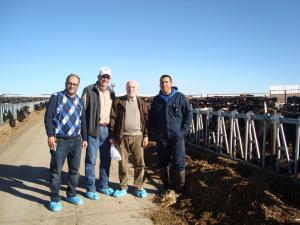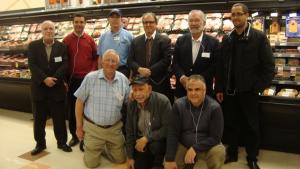A team of leaders from COPAG, a dairy and beef cattle cooperative in Morocco, traveled to Texas last week to see firsthand state-of-the-art beef feeding, harvesting and processing on a learning journey sponsored by the U.S. Grains Council (USGC). In addition, they learned about management techniques that improve quantity and quality of beef harvested.
Morocco’s beef sector had an annual production level of 254,000 tons in 2014, which is 50 percent higher than 2008. This achievement is directly related to the implementation of an agricultural development plan known as the Green Morocco Plan, which aims to aggregate small farmers into investment projects that help them capture added value of their crops and build their operations.
The plan aimed for the beef sector to increase production by 80 percent to reach 310,000 tons with a per capita consumption of 10 kilograms by 2020. To achieve this increase in production, the Moroccan beef industry must use improved genetics, feed more animals to heavier weights and increase the grain and co-products inclusion rates in ruminant diets.
To this end, the group visiting the United States last week stopped at university meat research labs, beef feeding operations, dairy farms relying on beef genetics for improving income, beef harvest facilities and beef retail outlets. Those on the team left the United States with an improved understanding of the link between feeding high-quality grain and producing quality beef.
“COPAG is seriously considering adopting several of the techniques studied during this trip to Texas, which will help them becoming the driving force for the modernization of the Moroccan beef industry,� said USGC Consultant Mustapha El Youssoufi. “It will also be a factor for boosting demand for better beef products in Morocco, which will lead to more grain and co-products being utilized within the Moroccan ruminant industry.�
Morocco imported 297,920 tons (11.7 million bushels) of U.S. corn during the 2014/2015 marketing year and has already purchased 71,823 tons of distiller’s dried grains with solubles (DDGS) as of September this calendar year. This country is a growing market for U.S. coarse grains as it continues to develop a taste for additional protein sources like meat, milk and eggs that require grains for production.
“COPAG has been our showroom for good dairy production and management,� Youssoufi said. “Following this trip the organization will soon undertake a successful integrated beef project that will serve as a demonstration for other groups with constraints of small livestock holders, not only in Morocco, but in North and Sub-Saharan Africa where the model is already being exported.�



